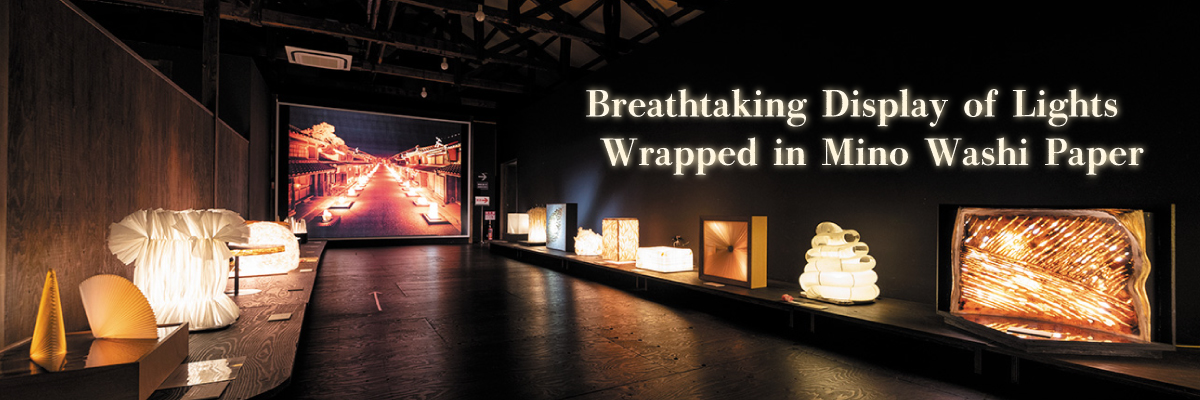
In October, in the middle of autumn, the historical and picturesque streets of Mino City in Gifu Prefecture are enveloped in the breathtaking glow of countless paper lanterns. The Mino Washi Akari Exhibition, now in its 30th year, is a contest and event celebrating traditional Japanese washi paper made in Mino, a city with a 1,300-year history of making this paper by hand. In response to a public call for three-dimensional paper-lantern art made with the Mino Washi paper and illuminated by a light source, submissions are displayed along the city’s Edo-style streets, and the winning entries are awarded prizes. Mino Washi ranks as one of the three best washi papers in Japan, and the soft light that filters through this high-quality paper embodies both the fresh charm of washi and the spirit of the people who live in Mino.
Illuminated exhibition of creative paper-lantern art glow in the dark night, showcasing the fine qualities of Mino Washi
Mino City in Gifu Prefecture is located in a valley about an hour’s drive north of Nagoya. The city has a long history of prospering with the Japanese paper industry. The washi still made here today, using the traditional handcrafting method and carefully selected materials, is a strong, beautiful Japanese paper renowned for its high quality. Mino Washi has a very long history. Shosoin, the treasure house of Todai-ji Temple in Nara, has in its collection a family registry written on Mino Washi that dates back to 702 AD. Made more than 1,300 years ago, the survival of this sheet of Mino Washi testifies to its outstanding durability and long shelf life. Hon-minoshi, a particular type of Mino Washi made with strictly prescribed raw materials and production methods, was designated an Intangible Cultural Property of Japan in 1969, and the traditional technique used to make it was registered as UNESCO Intangible Cultural Heritage in 2014. The sophisticated texture and delicate functionality of Mino Washi has captivated hearts and minds not only in Japan, but around the world.


“The Mino Washi Akari Exhibition was started to communicate a new kind of washi charm,” explains Hidetaka Furukawa, director of the Mino Washi Akari Art Gallery. Although washi has long been an integral part of Japanese life and an essential element in Japanese culture, changing lifestyles have meant fewer opportunities to encounter washi in everyday life. The Mino Washi Akari Art Exhibition began with the wish to give people the opportunity to rethink the merits of washi and to rediscover its charms.“Every year I am amazed at the new and ingenious ways Mino Washi is used inthese pieces to highlight its qualities as a material and show off the way light shines through the paper. I hope people will pay attention to the potential for new uses of washi as they view the beautiful scenes of light shining through washi, which blend so naturally with the old streets of Mino,” says Furukawa.


|
The Mino Washi Akari Art Gallery building is a modern wooden structure built in 1941, originally to house the Mino Washi Industry Hall, and it is a designated Tangible Cultural Property in Japan. Mino Washi lantern art is for sale at the first-floor store, and the second floor is dedicated to the exhibition of award-winning works from previous years. |
Furukawa serves as director of the Mino Washi Akari Art Gallery, a museum that displays recreated scenes from the Mino Washi Akari Art Exhibition. Previous years’ prize-winning works, from the first exhibition in 1994 to the 29th exhibition held last year, are on regular rotation, allowing visitors to enjoy there wonderful beauty all year long. In addition to General Division works crafted using sophisticated art techniques, the uninhibited and imaginative handmade lanterns submitted by elementary and junior high school students are also a highlight of the exhibition.
Furukawa says, “The girl who entered The Sheep That Ate the Rainbow, which won the Grand Prize in the Elementary/Junior High School Division at the 15th exhibition, was in the fourth grade at the time. She has already graduated from university and is now working as an elementary school teacher. Her students came to the museum recently, saying, ‘We came to see our teacher’s art.’ I was so pleased to see
Mino’s traditional washi culture being passed down from generation to generation, and it struck me again how this event forges connections among the local community.”
Many people in Mino, from children to adults, also participate in the event as volunteers. Perhaps the subtle feeling of comfort that the glow of Mino Washi paper-lantern art gives everyone who sees it comes from the spirit of the people of Mino, whose lives are so connected to this handmade paper.

The Sheep That Ate the Rainbow, Grand Prize winner in the Elementary/Junior High School Division at the 15th exhibition. The previous Emperor and Empress of Japan complimented this work for its colorful washi paper when they visited the museum.

Hidetaka Furukawa
Director, Mino Washi Akari Art Gallery
Director, Former Imai Residence and Mino Washi Museum

|
Mino Washi Akari Art Gallery
Address: 1901-3 Motozumi-cho, Mino City, Gifu Prefecture
Business hours: April – September, 9:00 – 16:30
October – March, 9:00 – 16:00 Last admission 15 minutes before closing
Holidays: Tuesdays (following day if national holiday), New Year holidays (December 29 – January 3), day after national holiday
Admission: Adult (high school student and older) 200 yen
Tel: +81-575-33-3772 |
